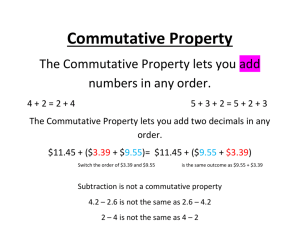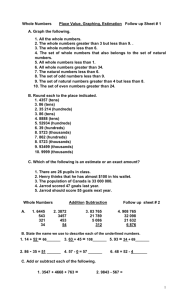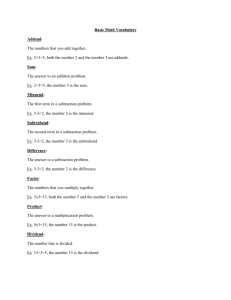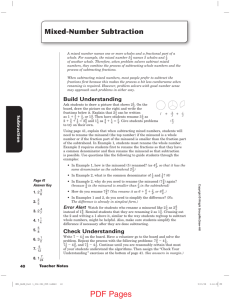Counting-Up Subtraction
advertisement
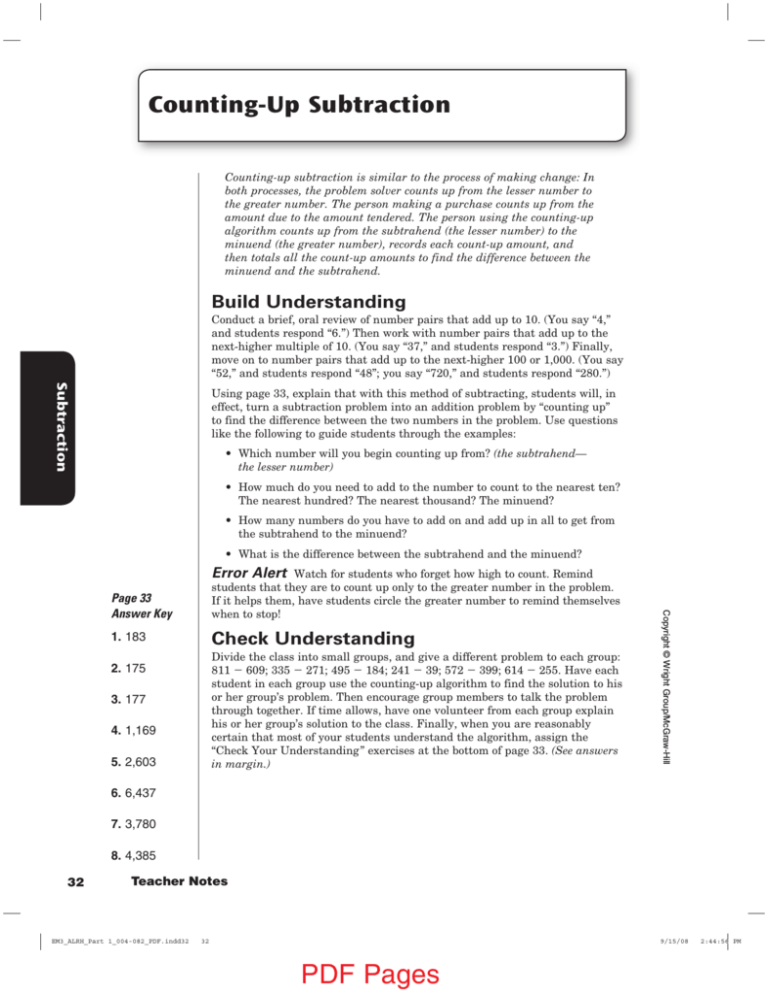
Counting-Up Subtraction Counting-up subtraction is similar to the process of making change: In both processes, the problem solver counts up from the lesser number to the greater number. The person making a purchase counts up from the amount due to the amount tendered. The person using the counting-up algorithm counts up from the subtrahend (the lesser number) to the minuend (the greater number), records each count-up amount, and then totals all the count-up amounts to find the difference between the minuend and the subtrahend. Build Understanding Conduct a brief, oral review of number pairs that add up to 10. (You say “4,” and students respond “6.”) Then work with number pairs that add up to the next-higher multiple of 10. (You say “37,” and students respond “3.”) Finally, move on to number pairs that add up to the next-higher 100 or 1,000. (You say “52,” and students respond “48”; you say “720,” and students respond “280.”) Subtraction Using page 33, explain that with this method of subtracting, students will, in effect, turn a subtraction problem into an addition problem by “counting up” to find the difference between the two numbers in the problem. Use questions like the following to guide students through the examples: • Which number will you begin counting up from? (the subtrahend— the lesser number) • How much do you need to add to the number to count to the nearest ten? The nearest hundred? The nearest thousand? The minuend? • How many numbers do you have to add on and add up in all to get from the subtrahend to the minuend? • What is the difference between the subtrahend and the minuend? 1. 183 Check Understanding Divide the class into small groups, and give a different problem to each group: 811 − 609; 335 − 271; 495 − 184; 241 − 39; 572 − 399; 614 − 255. Have each student in each group use the counting-up algorithm to find the solution to his or her group’s problem. Then encourage group members to talk the problem through together. If time allows, have one volunteer from each group explain his or her group’s solution to the class. Finally, when you are reasonably certain that most of your students understand the algorithm, assign the “Check Your Understanding” exercises at the bottom of page 33. (See answers in margin.) 2. 175 3. 177 4. 1,169 5. 2,603 Copyright © Wright Group/McGraw-Hill Page 33 Answer Key Error Alert Watch for students who forget how high to count. Remind students that they are to count up only to the greater number in the problem. If it helps them, have students circle the greater number to remind themselves when to stop! 6. 6,437 7. 3,780 8. 4,385 32 Teacher Notes EM3_ALRH_Part 1_004-082_PDF.indd32 32 9/15/08 PDF Pages 2:44:56 PM Name Date Time Counting-Up Subtraction Start with the subtrahend and decide by how much you want to count up first. Count up, recording the “count-up” amount. Continue counting up until you reach the minuend. Then, to find the difference between the subtrahend and the minuend, find the total of all the count-up amounts. 729 - 518 Count up from 518 to 729. → Then total all the count-up amounts. 211 is the difference. +2 + 80 + 100 + 29 211 → → → → 9,438 - 8,167 Example 2 Count up from 8,167 to 9,438. Copyright © Wright Group/McGraw-Hill 520 600 700 729 Subtraction Example 1 → Then total all the count-up amounts. 1,271 is the difference. +3 + 30 + 800 + 438 1,271 → → → → 8,167 8,170 8,200 9,000 9,438 Check Your Understanding Solve the following problems. 1. 814 − 631 2. 197 − 22 3. 555 − 378 4. 6,097 − 4,928 5. 7,112 − 4,509 6. 8,836 − 2,399 7. 93,744 − 89,964 8. 10,115 − 5,730 Write your answers on a separate sheet of paper. EM3_ALRH_Part 1_004-082_PDF.indd33 33 Student Practice 33 9/15/08 PDF Pages 2:44:56 PM
